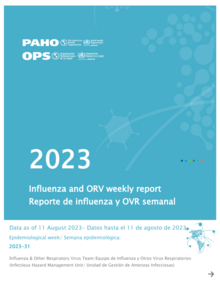North America: Influenza activity has remained at low levels. During the last 4 epidemiological weeks (EW), the predominant influenza viruses have been influenza A(H1N1)pdm09, with concurrent circulation of influenza B/Victoria. Respiratory syncytial virus (RSV) activity has remained low. SARS-CoV-2 activity has shown an increase in the last 4 EWs and continues to circulate at moderate levels. Cases of influenza-like illness (ILI) and severe acute respiratory infection (SARI) have remained at low levels, with the majority of these associated with SARS-CoV-2 and to a lesser extent influenza. In Mexico, moderate levels of influenza circulation have been detected in the last EWs; however, the activity ILI and SARI remains low but above the epidemic threshold.
Caribbean: After an increase in previous weeks, influenza activity has shown a decreasing trend in the last 4 EWs. During the last 4 EWs, the predominant influenza viruses have been B/Victoria, with lesser circulation of influenza A, mainly A(H1N1)pdm09. RSV activity has remained low. After showing an increase, the activity of SARS-CoV-2 has exhibited a fluctuating trend with intermediate levels of circulation. Cases of ILI and SARI, after an increase due to positive cases of influenza and SARS-CoV-2 in previous EWs, have shown a decreasing trend in the last 4 EWs.
Central America: Influenza activity, after reaching a peak in previous weeks, continues decreasing in the last 4 EWs. During the last 4 EWs, the predominant influenza viruses have been influenza A, mainly A(H1N1)pdm09, with concurrent circulation of influenza B/Victoria and influenza A(H3N2) to a lesser extent. RSV activity has shown an increase in the last 4 EWs, reaching intermediate levels of circulation. SARS-CoV-2 activity has shown a slight increase. ILI activity has remained low, with the majority of cases associated with influenza. SARI activity is currently declining, with the majority of cases associated with influenza and RSV. In Costa Rica, extraordinary levels of influenza positivity have been observed, coinciding with concurrent circulation of SARS-CoV-2, with low ILI and SARI levels, with the majority of cases associated with influenza and to a lesser extent SARS-CoV-2. In El Salvador, extraordinary levels of influenza positivity have been reported in the last 4 EWs, although currently in decline, with epidemic levels in reported SARI cases. Additionally, an increase in RSV positivity levels has been observed with elevated activity. In Honduras, after reaching high percentages of influenza positivity, a decline has been observed in the last 4 EWs with levels below the epidemic threshold. SARI cases are currently declining, with almost all positives related to influenza. In Guatemala, RSV activity remains at moderate levels of circulation, showing moderate levels of ILI and SARI activity, with ILI cases mostly positive for influenza and SARI cases mostly positive for RSV. In Nicaragua and Panama, after moderate activity levels reached in previous EWs, influenza positivity in both countries is currently at epidemic levels.
Andean region: Influenza activity remains stable at low levels. During the last 4 EWs, the predominant influenza viruses have been influenza A, mostly A(H1N1)pdm09, with lesser circulation of influenza B/Victoria. RSV activity remains at low levels. SARS-CoV-2 has presented a decreasing trend in the last 4 EWs, circulating at moderate levels, with elevated circulation in Bolivia. SARI activity continues to decline, with the majority of cases associated with influenza and to a lesser extent RSV and SARS-CoV-2. ILI activity has shown a decreasing trend, with the majority of cases associated with influenza.
Brazil and Southern Cone: Influenza activity has decreased to low circulation levels. During the last 4 EWs, the predominant influenza viruses have been mainly A(H1N1)pdm09, with simultaneous circulation of influenza B/Victoria. RSV activity has shown a decline in the last 4 EWs, reaching low circulation levels. SARS-CoV-2 activity has remained low. After reaching a peak, both SARI and ILI activity have continued to decline in the last 4 EWs, with the majority of cases positive for RSV and influenza in the case of SARI and influenza in ILI cases. In Argentina, the epidemic levels of influenza activity persist, with the majority of detected cases testing positive for influenza A(H1N1)pdm09. After reaching moderate levels of ILI activity, it is currently on the decline. In Brazil, the activity of influenza and SARS-CoV-2 continues to decrease, with SARI activity remaining above the epidemic threshold and the majority of SARI cases are linked to RSV, with influenza playing a smaller role. In Chile ILI activity remains at moderate levels with the majority of cases related to RSV and influenza. Also, after reaching moderate activity levels for SARI, it is currently declining at epidemic levels, with RSV being the most common cause among positive cases. In Paraguay, the activity of SARI has shown a decrease, reaching moderate levels, with RSV being the primary cause among positive cases. In Uruguay, a slight increase in SARI activity has been observed in the last EWs, with the majority of cases being associated with RSV.
|

